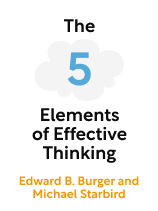

This article is an excerpt from the Shortform book guide to "The 5 Elements of Effective Thinking" by Edward B. Burger and Michael Starbird. Shortform has the world's best summaries and analyses of books you should be reading.
Like this article? Sign up for a free trial here.
Does it matter where ideas come from? How could that understanding help you solve problems?
When you understand where an idea came from, you’ll better understand the idea in the present and where it could go in the future. In The 5 Elements of Effective Thinking, Edward B. Burger and Michael Starbird explain how you can leverage this understanding to improve your problem-solving abilities.
Keep reading to learn how to understand the evolution of ideas and to use history as a guide to the future.
The Evolution of Ideas
Ideas are often taught outside of the context of their origins, making it seem like they sprang up out of nowhere, but the formation of a new idea is a cumulative process that never really ends. Ideas tend to be formed through the processes detailed in earth, fire, and air. Understanding the evolution of ideas can help you approach projects more effectively, and you can use that understanding to guide your thinking in the future.
| “Stealing” Ideas When we view ideas as organic epiphanies unrelated to other ideas before them, we end up becoming possessive over our ideas. Seeing someone get credit for an idea that you feel was yours, or that you think you thought of first, can be very frustrating and often leads to lawsuits in the professional and entertainment world. An idea can seem so personal and original to us that it’s difficult to conceive of the possibility that someone else could have had the exact same idea, but this happens surprisingly often. Viewing ideas this way is a feature of the heroic theory of invention, which is the belief that great ideas come directly from brilliant creators and innovators. This worldview suggests that people who come up with great ideas deserve high acclaim for their accomplishments specifically based on the assumption that that idea would never have existed if that specific person hadn’t come up with it. If someone who holds this theory has a great idea, then sees someone else express that same idea, they may naturally conclude that it was stolen from them. A common belief is that Thomas Edison, a famed inventor, actually stole many of his ideas from Nikola Tesla, though there is little historical evidence to back that up. But the belief behind this “feud” between the two inventors relies on the assumption that their ideas were so unique and original that no one else could have come up with them. There is a sort of hero worship surrounding these and other great minds that tends to ignore the foundational ideas on which these innovations were built. This is contrasted with the theory of multiple discovery, which acknowledges the ways in which ideas build upon each other to lead to great insight or innovation. The theory of multiple discovery explains that because of cumulative knowledge building, people who have never shared their ideas with each other may come up with the same ideas at the same time, without either party having “stolen” anything from the other. |
Principle 1: Understand the Evolution of an Idea
According to Burger and Starbird, knowing the foundation from which an idea developed gives you a better understanding of the idea in the present. No idea exists in a vacuum, and studying how an idea came about can make your foundational knowledge sturdier.
Further, when you understand how ideas develop and realize that new insights don’t appear out of nowhere, it’s easier to take things step by step. You can better manage your expectations and put less pressure on yourself to reinvent the wheel or magically spawn a huge, groundbreaking idea.
For example, if you view “Step #1” as “Invent a new type of video game console,” you’ll have a much harder time getting started than if you viewed it as “Learn how modern consoles were invented.”
(Shortform note: In Smarter Faster Better, Charles Duhigg suggests innovating by combining multiple old ideas into new ones. He offers this as a middle point between simply using an old idea by itself and creating a brand new idea out of thin air. Using the old ideas as a starting point makes the task less daunting, and combining them creates new ideas from the old.)
Principle 2: Use History as a Guide for the Future
Once you understand the past behind your idea, you can use that knowledge to “solve” your problem in the present, but the story doesn’t end with the “solution.” According to the authors, effective thinking develops an idea past the point at which it seems to be perfected. Once you’ve overcome a problem, look for new ways to use the solution, whether in continuation of your current topic or in a different field entirely.
Think several steps ahead of where you are now. Consider how the idea you’re working on might lead to things that are currently unheard of. For example, if you went back in time to the year 1800 and showed someone a photograph, they’d be flabbergasted and would dubiously ask you what artist was able to paint something so highly detailed. Fast forward 220 years and we have managed to portray moving images that look so realistic it feels like you’re seeing them in person. Where might our photo and video technology be in another two centuries?
(Shortform note: While it’s important to consider the potential future of your ideas, Duhigg points out in Smarter Faster Better that you also run the risk of becoming so attached to your current idea that you focus on pursuing it and ignore alternative ideas that may work better. If it was extremely difficult to come up with your current idea, it can be just as difficult to let that idea go and focus on another one when it seems to be the better option.)

———End of Preview———
Like what you just read? Read the rest of the world's best book summary and analysis of Edward B. Burger and Michael Starbird's "The 5 Elements of Effective Thinking" at Shortform.
Here's what you'll find in our full The 5 Elements of Effective Thinking summary:
- The 5 principles for learning to think effectively
- What it means to learn beyond memorizing
- Why you need to be willing to change if you want to learn






